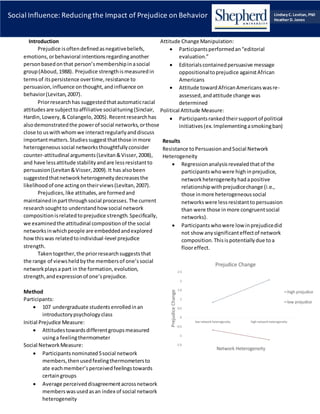
Poster Handout
- 1. Social Influence: Reducingthe Impact of Prejudice on Behavior Lindsey C. Levitan, PhD Heather D. Jones Introduction Prejudice isoftendefinedasnegativebeliefs, emotions,orbehavioral intentionsregardinganother personbasedonthat person’smembershipinasocial group(Aboud, 1988). Prejudice strengthismeasuredin termsof itspersistence overtime,resistance to persuasion,influence onthought,andinfluence on behavior(Levitan,2007). Priorresearchhas suggestedthatautomaticracial attitudesare subjecttoaffiliative socialtuning(Sinclair, Hardin,Lowery,& Colangelo,2005).Recentresearchhas alsodemonstratedthe powerof social networks,orthose close to uswithwhomwe interactregularlyanddiscuss importantmatters.Studiessuggestthatthose inmore heterogeneoussocial networksthoughtfullyconsider counter-attitudinal arguments(Levitan&Visser,2008), and have lessattitude stabilityandare lessresistantto persuasion(Levitan&Visser,2009).It has alsobeen suggestedthatnetworkheterogeneitydecreasesthe likelihoodof one actingontheirviews(Levitan,2007). Prejudices,like attitudes,are formedand maintainedinpartthroughsocial processes.The current researchsoughtto understandhowsocial network compositionisrelatedtoprejudice strength.Specifically, we examinedthe attitudinal compositionof the social networksinwhichpeople are embeddedandexplored howthiswas relatedtoindividual-level prejudice strength. Takentogether,the priorresearchsuggeststhat the range of viewsheldbythe membersof one’ssocial networkplaysapart in the formation,evolution, strength,andexpressionof one’sprejudice. Method Participants: 107 undergraduate studentsenrolledinan introductorypsychologyclass Initial Prejudice Measure: Attitudestowardsdifferentgroupsmeasured usinga feelingthermometer Social NetworkMeasure: Participantsnominated5social network members,thenusedfeelingthermometersto ate eachmember’sperceivedfeelingstowards certaingroups Average perceiveddisagreementacrossnetwork memberswasusedasan index of social network heterogeneity Attitude Change Manipulation: Participantsperformedan“editorial evaluation.” Editorialscontainedpersuasive message oppositionaltoprejudice againstAfrican Americans Attitude towardAfricanAmericanswasre- assessed,andattitude change was determined Political Attitude Measure: Participantsrankedtheirsupportof political initiatives(ex.Implementingasmokingban) Results Resistance toPersuasionandSocial Network Heterogeneity Regressionanalysisrevealedthatof the participantswhowere highinprejudice, networkheterogeneityhadapositive relationshipwithprejudicechange (i.e., those inmore heterogeneoussocial networkswere lessresistantto persuasion than were those inmore congruentsocial networks). Participantswhowere low inprejudicedid not show anysignificanteffectof network composition.Thisispotentiallydue toa flooreffect.
- 2. Social Influence: Reducingthe Impact of Prejudice on Behavior Lindsey C. Levitan, PhD Heather D. Jones Regressionanalysisrevealedthat prejudice predictedfeelingstowardasmokingbanfor those inmore congruentsocial networks. However,forthose inmore heterogeneous social networksprejudice wasnota good predictorof feelingstowardasmokingban. Discussion These resultssuggestthatthose inmore heterogeneoussocial networkshave weakerprejudices than dothose in more congruentsocial networks.Inthe case of prejudice againstAfricanAmericans,this relationshipbetweennetworkheterogeneityand prejudice strengthseemsto be particularlytrue of those withhighlevelsof prejudice. Those whohad higherlevelsof prejudice against AfricanAmericanswere lessresistanttochangingtheir viewswheninaheterogeneoussocial network.However, presumablybecause thosewithlowlevelsof prejudice againstAfricanAmericanswere alreadyatthe lower thresholdof ourscale,theydidnotshowany significant effectof networkcomposition. For prejudice involvingsmokers,itwasfoundthat prejudice wasonlyapredictorof feelingstowarda smokingbanfor those inmore congruentsocial networks. Thisindicatesthatan individual’sprejudice hasmore of an influence onthoughtif the personisimbeddedina more congruentsocial network.Inotherwords,havinga more heterogeneous social networkdecreasesthe probabilitythatanindividual’sprejudice will influence theirthoughts/attitudes. These resultsindicate thatthe processesinvolvedinthe formation,maintenance,evolution,andexpressionof prejudicesare notsolelyindividual-level processes,butalso complex social processesinwhichthe prejudicesandbeliefs heldbymembersof the social networkinwhichthe individualis imbeddedare animportantcomponent. References Aboud,F.(1988). Children&Prejudice:The Development of EthnicAwareness&Identity.NewYork,NY: Blackwell. Levitan,L.C., & Visser,P.S.(2009). Social network compositionandattitude strength:Exploringthe dynamicswithinnewlyformedsocial networks. Journal of Experimental SocialPsychology,45(5), 1057-1067. Levitan,L.C., & Visser,P.S.(2008). The impactof the social contextonresistance topersuasion:Effortful versuseffortlessresponsestocounter-attitudinal information.Journal of ExperimentalSocial Psychology,44(3),640-649. Levitan,L.C. (2007). Givingprejudice anattitude adjustment:The implicationsof attitude strength and social networkattitudinal compositionfor prejudice andprejudice reduction.The Universityof Chicago. Sinclair,S.,Hardin,B.S.,Lowery,C.D.,& Colangelo,A. (2005). Social Tuningof AutomaticRacial Attitudes: The Role of Affiliative Motivation.Journalof PersonalityandSocial Psychology,89(4),583-592.